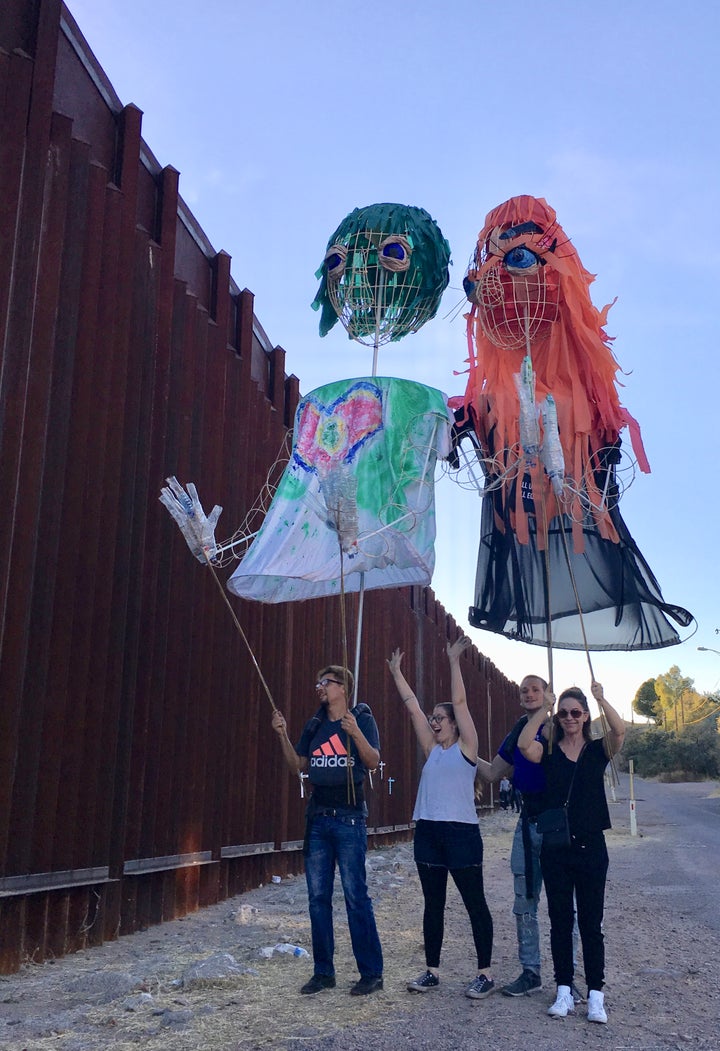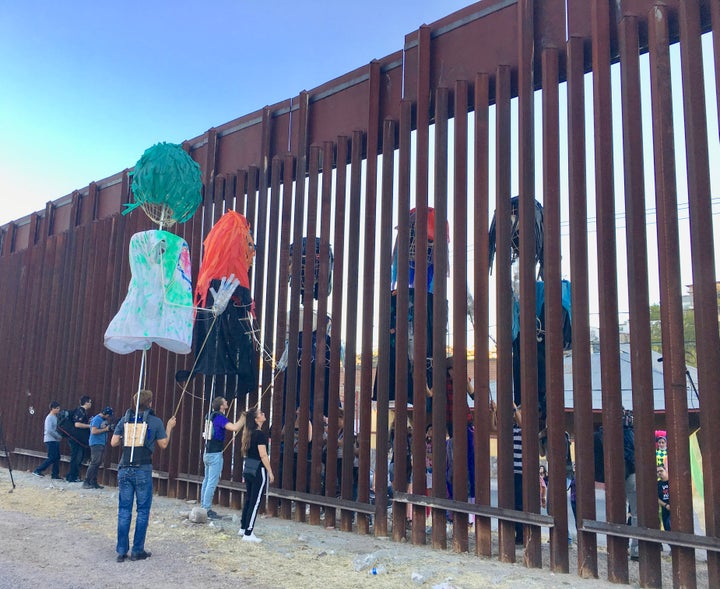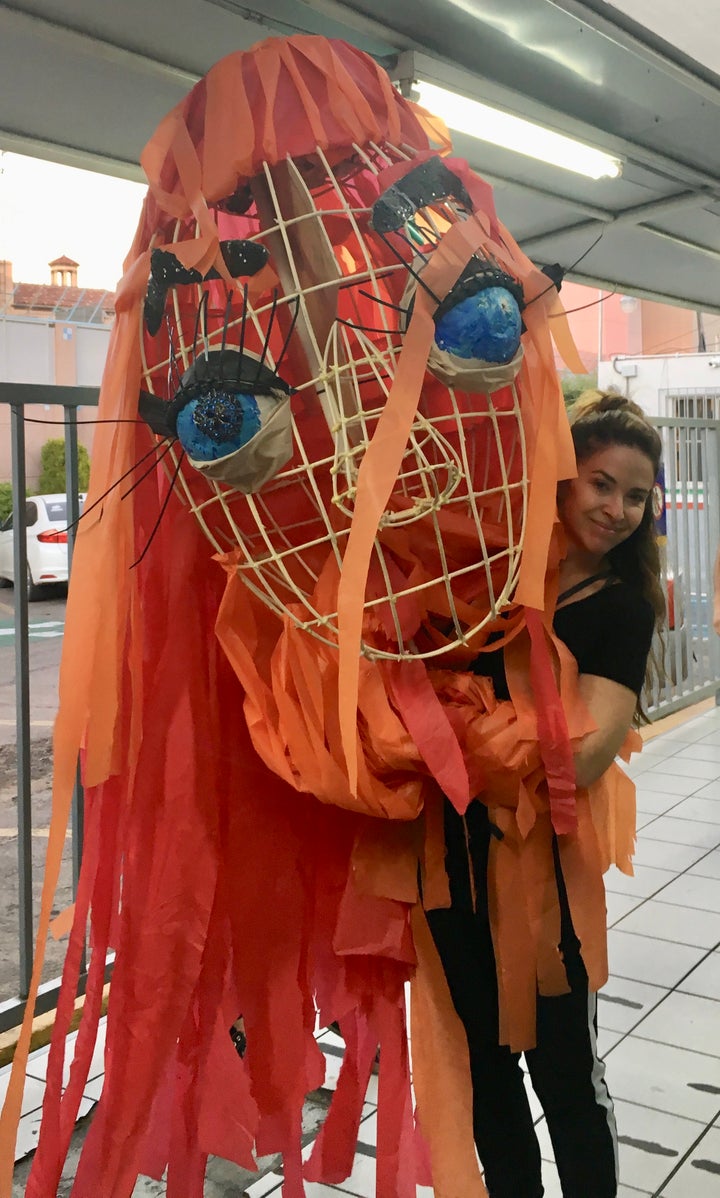
Artist Puppetistas on the U.S. side of the Border Wall
Einstein said famously: “The true sign of intelligence is not knowledge but imagination.”
He also noted, “Play is the highest form of Research.”
Recent happy postings on social media herald the imagination of Artist-Activists at the U.S.-Mexico border wall as they continue to shine a light on government attempts to split neighbors, block migratory pathways, and desecrate unique borderlands.
We need all the imagination, holy mischief, and mirth we can find if we want to be smart and save our sandbox. Perhaps we ought to spend more time in the culture of children.
“Mirth is God’s Medicine.” Henry Ward Beecher, Abolitionist (1813-1887)
Since the inception of this administration, visual artists have stepped up their game with projects that are bold and unforgettable. Who can forget the massive photo cut-out of a giant baby peering over the wall by French Artist JR? Or our mighty Jaguar and other threatened border species projected on the wall by eco-artist Lauren Strohacker… or the many sunny murals by children and articulate graffiti springing up like wildflowers. Whitewash them out, paint them over, erase these voices from the streets… and watch them return.
This month on November 22, a light brigade of artists projected ironic imagery: the statue of liberty, a ladder, a Luche Libra mask up and over the existing wall onto prototypes of a “new” border wall, using light, a fitting medium not easily contained, shifting like water, like air, like laughter…
“The way to face the power of the government has always been with humor and comedy,” lead brigade artist Jill Marie Holslin reminds us.
Three days later on November 25, giant Puppets on the U.S. side of the wall consorted with giant puppets on the Mexico side. 15 ft. tall Puppets with huge bulbous eyes and dreadlocks, danced and waved great outstretched hands with fingers created from plastic water bottles.
On the Nogales, Arizona side of the wall, the huge puppets hoisted onto the shoulders of young Puppetistas, swayed from side to side, and then oh so naughty, they reached through the slats in the 18 foot wall and touched the puppets on the Nogales, Sonora, Mexico side.

U.S. & Mexican Puppets challenge the wall
“Prepare for mirth, for mirth becomes a feast.” William Shakespeare, (1564-1616)
The Giant Border Puppets may not have come into being if it were not for the children. According to Jess Kaufman, lead artist and producer of Puppets on the Border, a chance encounter with children jumping a fence in a Brooklyn Park sparked the idea. The fence was no obstacle for kids.
“I thought, what if we could use puppets at this scale to turn our border wall into an object of play?” she asked.
She immediately contacted her friend and collaborator Ana Diaz Barriga, a professional puppeteer in Mexico City.
“I said, let’s make this happen!” Kaufman smiled, the wonder of it all still fresh in her eyes.
“So much of what we hear today has to do with turning the wall into an object of division, an object of fear but kids are able to see infinite possibilities even in a wall. We can shift our perception,” she said.
They got to work right away, building partnerships nationally and locally, seeking sponsors and crowdsourcing the funding for the project.
“We are coming from the East coast and from Mexico City and everything we’ve heard about the border is simply not true,” Kaufman said.
“There is not a division between American culture and Mexican culture. It’s a Borderlands culture. It’s one fusion but all we hear about is this wall. We’re really interested in breaking down those hard lines between us.”
“And I say that from a cultural perspective, a faith perspective, and a political perspective,” she adds.
“We are inter-faith and multi-denominational… Jewish, Christian and Catholics. We are bi-cultural and multi-lingual and we have collaborators all over the world.”
Two Moslem women behind us in the crowd wearing bright hijabs and heart-shaped sun glasses, agree.
“Politics is usually serious but we try to focus on fun, joy and love,” one of the women says.
“We sponsor puppets at the border because its synonymous with our message which is to see the world with eyes of love,” says the other, pointing to their heart-shaped glasses now worn by people world-wide.
We walk together for a moment in silence along the U.S. side of the wall to the Nogales Pedestrian Port of entry where we will cross the border as a group to the Mexico side.
Puppet components were built by the artists this year in a residency in New York, and in Connecticut, and most recently in an Intensive at the Museo de Arte in Sonora, Mexico. They were then completed by students in primary school to college in Nogales, Sonora. Teenagers in Secondary school took the initiative to engineer the designs themselves, to be lighter, easier to carry.
They used anything that worked: Electrical aluminum conduit for the spines, head and arm pieces molded from reed, hula hoops and upcycled fabric for the arms, plastic tablecloth covers for the puppet’s hair and costumes, backpacks from goodwill, and “lots of PVC.”
As the crowd reached the Port of Entry, the puppets are taken apart to fit through the pedestrian gate. Giant heads come off and are taken through, dwarfing the volunteers who carry them. Puppet’s bodies trail behind.

Carrying the puppets in pieces through the U.S.- Mexico Border Port of Entry
We emerge onto the town square in the middle of the shopping district in Nogales, Mexico. The puppets are quickly put back together by volunteers and then carried aloft to meet their friends, the other puppets, “el otro lado,” on the other side.
There, we meet Producer and Puppeteer Ana Diaz Barriga.
“This is not a protest. Anger doesn’t change anything.” she says.
“We are trying a new approach. We want to celebrate the diversity of border culture: the culture of the town of Nogales, Arizona and Nogales, Sonora in Mexico as one.”
The group has had interest from supporters in Israel who would like the puppets to grace the wall at Gaza.
“People here would like to make this an annual event. We’ll see how it all plays out,” Kaufman says.
“Life must be lived as play,” Plato (427 BC. – 347 BC.)
Both Kaufman and Barriga have backgrounds in Improvisational theatre and prefer to be spontaneous.
“That’s the way children are too,” says Kaufman. “In this country, right now we have such division and rhetoric and hard lines and kids and artists don’t think like that. Kids and artists don’t work that way.”
All five of the massive puppets reached out to each other in the plaza and then danced around the central fountain to the delight of onlookers.
“These puppets turned out to be amazing dancers,” says Kaufman. “That’s the things about puppets. You never know what they’re good at until they show you. These puppets can even high five.”
PostScript
On my darkest days, I think we adults are a lost cause. We have lived too long and witnessed too much, especially here at the border where reality can feel especially grim. Scroogy politicians and security forces with dour faces and concrete thinking gather like buzzards in the trees, like storm clouds, like the apocalypse.
But as I followed the puppets that day, I caught myself grinning ear to ear. I cheered along with the crowd at the natural authority of puppets reaching through the slats and touching each other. There was a lightness in my step and my spirits soared as the crowd cheered. Pomp and scale, color and flavor graced the streets of Nogales on both sides of the wall that day. The puppet’s billowing skirts swept fresh air into the streets, a sweet relief from unimaginative affairs of men.
As day turned to night in Nogales, Sonora, I spotted Cecelia, a ten-year-old girl, part of the team of young creatives on the Mexican side who helped make the puppets.
“We made these puppets to celebrate Nogales,” she said proudly. Funny, she never said a thing about a wall.
Valarie Lee James
www.ArtandFaithintheDesert.wordpress.com
